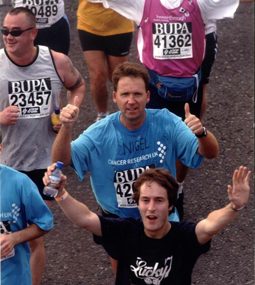
Geoscientist 17.4 April 2007
What does a geologist think about as he runs the London Marathon? In geology, you learn about time - a lot of time, says Nigel Platt…
As I look from my window upon the Surrey Downs, I see the Chalk and Greensand hills, walked by pilgrims heading east to Canterbury for eight hundred years and more. That seems a lot of time. But to the Earth, it’s nothing. Our planet is around 4.6 billion years old, give or take a few. That is a lot of time.
A new perspective is required, so let’s imagine the Earth’s own lifetime as a marathon course. The longest journey, but even in this unimaginable race, every 100 million years means just one kilometre in the London Marathon route from Greenwich to The Mall.
If the first half of any marathon is 32 kilometres long, and the second only nine and a half, then the Earth’s journey was much the same. Those early miles are largely lost to her geological biographers, and she has herself all but forgotten them. Only the meteorites’ vague radioactive memory recalls her startline euphoria at the birth of the solar system. Just a few fragments of battered crust in Greenland and South Africa remain to witness the long years of cooling as her race was warming up. The first 10km to the Cutty Sark, were virtually wiped for ever.
And after that, through South London’s streets, it was pretty quiet - for a very long time. Barren, wild, volcanic landscapes rose and were worn away, separated by empty oceans which opened, closed and re-opened unseen throughout long and lonely miles. There was no free oxygen in the air, but we have found microscopic filaments and strange bacteria-like structures in sedimentary rocks around three billion years old. Did these really live, or form as mineral aggregates? A question to fuel a lively debate among geologists; how can we confirm such simple life on distant Mars, when we’re not quite sure what to recognise as "life" at home?
Maybe it was around the 20km mark by Tower Bridge that saw the pattern for Earth’s race set at last. Primitive algae had appeared, forming mounds and crusts to drape those Precambrian shields. They ruled the Earth for 10km more, through Docklands, past Canary Wharf, and into the East End at Poplar. A slow release of oxygen was liberated by their photosynthesis, and a few soft-bodied creatures emerged just past Limehouse, with less than seven kilometres still to race.
Almost four billion years elapsed - and only slime and worms to show? The pace was hotting up, and our weary Earth was lifted by a sudden crowd as several new groups arose (by the Tower of London) with 5.5km left to run. Among them are many shells like those we find today. But these molluscs and corals would see no fish to swim between them for another long kilometre – since young Nemo’s ancestors can trace their line back only to St Paul’s.
For 38km along her run, Earth’s continents had been all but bare of life - but then the plants appeared. Giant forests rose and fell, leaving coal behind. Flowering species, and insects, graced the land as Earth reached Blackfriars, three kilometres from The Mall. And she was already on Embankment when the supercontinent Pangaea was formed, its vast deserts roamed by giant reptiles, while the Triassic seas ebbed and flowed around its shores.